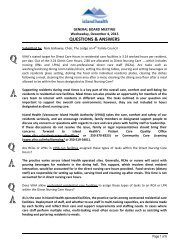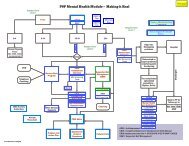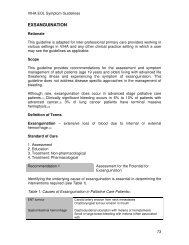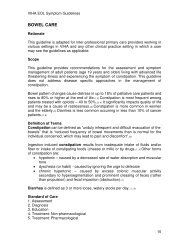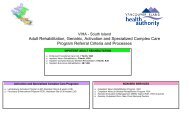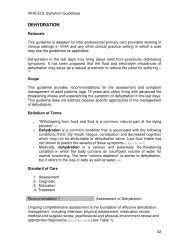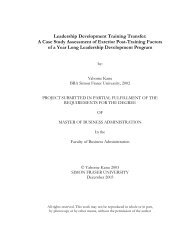North Island Hospitals Project Concept Paper - Vancouver Island ...
North Island Hospitals Project Concept Paper - Vancouver Island ...
North Island Hospitals Project Concept Paper - Vancouver Island ...
You also want an ePaper? Increase the reach of your titles
YUMPU automatically turns print PDFs into web optimized ePapers that Google loves.
<strong>North</strong> Islland Hospiitalls <strong>Project</strong><br />
<strong>Concept</strong> <strong>Paper</strong><br />
JJanuarryy 2010
Table of Contents<br />
2 0BIntroduction | <strong>Vancouver</strong> <strong>Island</strong> Health Authority<br />
<strong>North</strong> <strong>Island</strong> <strong>Hospitals</strong><br />
<strong>Project</strong> <strong>Concept</strong> <strong>Paper</strong><br />
Introduction ................................................................................................................................................... 3<br />
<strong>North</strong> <strong>Island</strong> ............................................................................................................................................... 8<br />
SITE INFORMATION ..................................................................................................................................... 10<br />
Existing Facility Capability to Provide Quality Care ................................................................................ 10<br />
St Joseph’s General Hospital ................................................................................................................... 10<br />
Campbell River and District Regional Hospital ........................................................................................ 12<br />
ALIGNMENT AND SCOPE ............................................................................................................................. 14<br />
Strategic Plan Alignment ........................................................................................................................ 14<br />
Alignment with Ministry of Health Services Strategic Priorities ............................................................. 15<br />
<strong>Project</strong> Objectives .................................................................................................................................... 17<br />
Service Delivery Model ............................................................................................................................ 17<br />
Model Results .......................................................................................................................................... 19<br />
Summary ................................................................................................................................................. 23<br />
FACILITY DEVELOPMENT ............................................................................................................................. 24<br />
Translating Demand into Physical Scope Development .......................................................................... 24<br />
Facility Space Requirements ................................................................................................................... 24<br />
Expected Benefits Resulting From Best Practice Design ......................................................................... 25<br />
APPROVAL REQUEST ................................................................................................................................... 26
Introduction<br />
3 0BIntroduction | <strong>Vancouver</strong> <strong>Island</strong> Health Authority<br />
<strong>North</strong> <strong>Island</strong> <strong>Hospitals</strong><br />
<strong>Project</strong> <strong>Concept</strong> <strong>Paper</strong><br />
On May 27, 2009 the Board of the <strong>Vancouver</strong> <strong>Island</strong> Health Authority (VIHA) approved a plan to<br />
build two new, state‐of‐the‐art, acute care hospitals in Campbell River and the Comox Valley<br />
(the <strong>Project</strong>). The Comox‐Strathcona Regional Hospital District (CSRHD) has passed a motion to<br />
support the <strong>Project</strong> scope as well to raise 40% of the capital cost for the new hospitals.<br />
Finding the right solution: Improved hospital care for the <strong>North</strong> <strong>Island</strong><br />
One of the most pressing priorities facing the <strong>Vancouver</strong> <strong>Island</strong> Health Authority is the need to<br />
establish a sustainable network of hospitals to meet the region’s acute care needs today and<br />
into the future.<br />
As we developed our Five‐Year Strategic Plan in 2005, we went through an extensive public<br />
consultation process with residents, staff, physicians, community partners, aboriginal leaders<br />
and other stakeholders, across every region of VIHA. Through this process, we identified a need<br />
for enhanced specialty services for <strong>North</strong> <strong>Island</strong> communities and residents.<br />
A diverse geography and population<br />
The <strong>North</strong> <strong>Island</strong> service area covers an enormous geographic area, extending from the<br />
northern tip of <strong>Vancouver</strong> <strong>Island</strong>, to south beneath the mid‐<strong>Island</strong> cities of Campbell River,<br />
Courtenay and Comox, as well as a substantial stretch of the mainland opposite <strong>North</strong>ern<br />
<strong>Vancouver</strong> <strong>Island</strong>, including communities north of Powell River and south of Rivers Inlet. The<br />
geography is large, covering approximately 40,322 square kilometers, which makes access to<br />
health care services more challenging than for residents in urban settings.
The need for renewal<br />
4 0BIntroduction | <strong>Vancouver</strong> <strong>Island</strong> Health Authority<br />
<strong>North</strong> <strong>Island</strong> <strong>Hospitals</strong><br />
<strong>Project</strong> <strong>Concept</strong> <strong>Paper</strong><br />
There are currently two hospitals serving this large and diverse area; the Campbell River and<br />
District General Hospital and St. Joseph’s General Hospital. Both hospitals are nearly 50 years<br />
old and their physical infrastructure is deteriorating. In the past number of years, each hospital<br />
has submitted requests for substantial capital investments to upgrade their facilities to<br />
approach current standards.<br />
Before undertaking upgrades requested, we assessed our current and projected future delivery<br />
of acute care services. We wanted to make a wise investment; one that would meet the needs<br />
of residents today and well into the future.<br />
Assessing the options<br />
In 2006, VIHA commissioned Turnkey Management Consulting to undertake an options<br />
appraisal for future acute care service delivery in the Comox‐Strathcona area. The firm looked<br />
at four options, including refurbishing and expanding the existing facilities and building a new<br />
regional hospital that would serve both major communities including providing services similar<br />
to those available at Nanaimo Regional General Hospital. Turnkey’s recommendation to VIHA<br />
was to build a new Regional Hospital at a site between Comox and Campbell River.<br />
In the summer of 2006, VIHA’s Board of Directors asked staff to take the consultant’s<br />
recommendation back to the community to get input and feedback. We held a series of town<br />
hall meetings, open houses, and smaller meetings with a wide range of stakeholders, including<br />
municipalities, First Nations leadership, physicians, and other health providers.<br />
Through this process, we identified an additional option and refined the existing options, and<br />
included those changes for the Board’s consideration. Although the intent of our consultation<br />
process had been to discuss how best to provide regional hospital services in the <strong>North</strong>, we<br />
discovered there was an overwhelming interest in discussing potential sites if the board<br />
recommended a single site regional hospital.<br />
The Board considered four options: a new regional hospital in the Campbell River area, a new<br />
regional hospital in the Comox area, regional hospital services delivered through both existing<br />
hospitals, and a phased investment process. In considering the options presented, the board<br />
considered public input and feedback, quality and safety issues, service sustainability, financial<br />
sustainability and access.
5 0BIntroduction | <strong>Vancouver</strong> <strong>Island</strong> Health Authority<br />
<strong>North</strong> <strong>Island</strong> <strong>Hospitals</strong><br />
<strong>Project</strong> <strong>Concept</strong> <strong>Paper</strong><br />
In September 2006, the Board voted to support the creation of a new <strong>North</strong> <strong>Island</strong> regional<br />
hospital located along the <strong>Island</strong> Highway within the Comox Valley. In this model, a somewhat<br />
reduced range of community hospital services would have been provided in Campbell River.<br />
The Board believed this option provided the greatest opportunity to deliver sustainable acute<br />
care services for the residents of the <strong>North</strong> <strong>Island</strong>.<br />
Listening to the community<br />
While originally supported by the Comox‐Strathcona Regional Hospital District (CSRHD), the<br />
Board’s decision met with significant concern. Concerns that were raised included: lack of basic<br />
infrastructure services at the proposed location, reduced local hospital services in Campbell<br />
River and the distance, time and environmental impact of travel to the proposed site. These<br />
concerns continued to grow in the months following the announcement and in response the<br />
CSRHD ultimately withdrew its support.<br />
To try and move the issue forward, the CSRHD established a task force of area physicians to<br />
propose a <strong>North</strong> <strong>Island</strong> acute care service delivery model that would meet the concerns<br />
expressed. It was unable to achieve consensus and disbanded.<br />
VIHA continued to work towards finding a solution that would work for <strong>North</strong> <strong>Island</strong><br />
communities, and that would help create the network of sustainable hospital services our<br />
residents need and deserve.
Assessing options<br />
6 0BIntroduction | <strong>Vancouver</strong> <strong>Island</strong> Health Authority<br />
<strong>North</strong> <strong>Island</strong> <strong>Hospitals</strong><br />
<strong>Project</strong> <strong>Concept</strong> <strong>Paper</strong><br />
During the summer and fall of 2008, we undertook further discussions and consultation with<br />
physicians, staff and municipal leaders from both Comox and Campbell River. Based on these<br />
discussions, four options for acute care in the <strong>North</strong> <strong>Island</strong> area emerged:<br />
• A single regional hospital between Campbell River and the Comox Valley<br />
• Build a new hospital in the Comox Valley and renovate Campbell River Hospital<br />
• Build a new facility in the Comox Valley and a new facility in Campbell River<br />
• Expand Nanaimo Regional General Hospital to provide regional services for the <strong>North</strong><br />
<strong>Island</strong> population, and maintain current bed base and services at Campbell River<br />
Hospital and St. Joseph’s Hospital, with necessary upgrades to both sites<br />
After listening to the concerns of residents, physicians and other stakeholders and considering<br />
these options carefully, VIHA’s Board endorsed proposing two new hospitals be built, one in<br />
Campbell River, the other in the Comox Valley.<br />
Adding more beds, preserving existing services, providing better care<br />
Combined the two hospitals would have about 250 beds, a total increase of 80 beds for the<br />
region. Both hospitals would continue to provide the same acute care services currently<br />
delivered with new services available at the Comox Valley hospital and additional mental health<br />
and addictions services available at Campbell River.<br />
Campbell River:<br />
• New 90‐95 bed hospital delivering the same services currently provided at Campbell<br />
River General Hospital<br />
• This is an addition of 30‐35 beds to the current bed base at Campbell River General<br />
Hospital<br />
• All currently provided services will continue at the new hospital<br />
• The new Campbell River facility will be built at the currently owned site at 2 nd Avenue,<br />
subject to site and planning approvals
7 0BIntroduction | <strong>Vancouver</strong> <strong>Island</strong> Health Authority<br />
<strong>North</strong> <strong>Island</strong> <strong>Hospitals</strong><br />
<strong>Project</strong> <strong>Concept</strong> <strong>Paper</strong><br />
• Additional Services to be provided in Campbell River:<br />
o <strong>North</strong> <strong>Island</strong> Regional Centre for Mental Health and Addictions will be located at<br />
the new hospital site and include beds and ambulatory services. The Centre will<br />
have a particular focus on the provision of culturally sensitive and appropriate<br />
services to the Aboriginal population on <strong>North</strong> <strong>Island</strong><br />
Comox Valley:<br />
• New 150‐160 bed hospital delivering the same services currently provided at St.<br />
Joseph’s General Hospital, replacing the 110 beds at this facility<br />
• Services currently provided will continue<br />
• The new Comox Valley Hospital will be built on a suitable site on a site yet to be<br />
determined<br />
• In addition, the Comox Valley Hospital would have 40‐50 beds for regional hospital<br />
programs, serving all residents of the Comox‐Strathcona/Mt. Waddington area. These<br />
services, which are currently not available on the <strong>North</strong> <strong>Island</strong>, include but may not be<br />
limited to:<br />
o MRI<br />
o Trauma Level 3<br />
o Inpatient Renal Services<br />
o Cardiac Medicine<br />
o Enhanced Cancer Care<br />
o Specialized Maternity and Nursery<br />
o Enhanced Seniors Care<br />
Bringing new regional services to the <strong>North</strong> <strong>Island</strong><br />
In addition to preserving all existing health care services in each community, we will be able to<br />
provide enhanced and new services to the region as a whole. This means:<br />
• Providing some services at both sites and others at one site having a single, integrated,<br />
medical, nursing and support service staff working across two sites<br />
• Establishing common and consistent clinical and patient safety standards at both sites<br />
• Creating flexible designs that ensure both new facilities can be adapted to changing<br />
community needs and medical practices
Better health care—better health outcomes<br />
<strong>North</strong> <strong>Island</strong> <strong>Hospitals</strong><br />
<strong>Project</strong> <strong>Concept</strong> <strong>Paper</strong><br />
New acute care facilities in the <strong>North</strong> <strong>Island</strong> offer VIHA and the Province the chance to create a<br />
new future for acute care on the <strong>North</strong> <strong>Island</strong> and set a new standard for acute care facilities.<br />
In particular, the <strong>North</strong> <strong>Island</strong> <strong>Hospitals</strong> will:<br />
• Demonstrate support for the history of forestry on the <strong>North</strong> <strong>Island</strong> by the inclusion of<br />
BC wood into the acute care structure and environment;<br />
• Potentially utilizing wood as a primary material in the construction of these new<br />
facilities thereby creating more jobs for <strong>North</strong> <strong>Island</strong> communities as well as setting a<br />
new benchmark for the use of wood in a hospital facility;<br />
• Incorporate “lean” design and construction resulting in a new level of sustainability for<br />
health care by reducing resource consumption, capital cost, operating costs and ongoing<br />
human resource requirements;<br />
• Establish a new level of sustainability by setting LEED Gold as the minimum requirement<br />
for Campbell River; and<br />
• Leverage opportunities to partner with post secondary institutions to create a new<br />
collaborative model for fostering the development of health care professionals.<br />
<strong>North</strong> <strong>Island</strong><br />
VIHA serves approximately 750,000 people and<br />
is organized into three Health Service Delivery<br />
Areas: South <strong>Vancouver</strong> <strong>Island</strong> (370,000),<br />
Central <strong>Vancouver</strong> <strong>Island</strong> (258,000), and <strong>North</strong><br />
<strong>Vancouver</strong> <strong>Island</strong> (122,000).<br />
BC Stats is projecting a 12% population growth<br />
in the <strong>North</strong> <strong>Island</strong> to a total of 137,000 with<br />
the majority (83%) of the net growth occurring<br />
in the Comox Valley. The growth in the older adult population is projected to be even more<br />
pronounced ‐ the forecast to 2013 for the population aged 75 and over is for a growth rate<br />
almost three times that of VIHA overall.<br />
8 0BIntroduction | <strong>Vancouver</strong> <strong>Island</strong> Health Authority
<strong>North</strong> <strong>Island</strong> <strong>Hospitals</strong><br />
<strong>Project</strong> <strong>Concept</strong> <strong>Paper</strong><br />
About twice as many residents in the <strong>North</strong> Area identify as Aboriginal compared to VIHA as a<br />
whole. This population is slightly younger than in the whole of VIHA, with a relatively small<br />
population aged 75 and over.<br />
Aboriginal Population as a % of Total Population<br />
(2006 Census)<br />
<strong>North</strong>ern Health Authority<br />
Interior Health Authority<br />
<strong>Vancouver</strong> <strong>Island</strong> Health Authority<br />
BC<br />
Fraser Health Authority<br />
<strong>Vancouver</strong> Coastal Health Authority<br />
2.7%<br />
2.4%<br />
4.8%<br />
6.7%<br />
5.8%<br />
17.5%<br />
0.0% 2.0% 4.0% 6.0% 8.0% 10.0%12.0%14.0%16.0%18.0%20.0%<br />
Compared to the rest of VIHA, the <strong>North</strong> <strong>Island</strong> region has the poorest health status. Teenage<br />
pregnancy rates are high and life expectancy is approximately one year shorter than for more<br />
southern residents of the Health Authority. The overall death rate is also higher than in VIHA,<br />
with a significant number of deaths due to suicide and alcohol abuse. Lower education levels<br />
and high unemployment rates likely contribute to the poorer health status of the population.<br />
People who live on the <strong>North</strong> <strong>Island</strong> are admitted to hospital more frequently than elsewhere in<br />
the Health Authority.<br />
VIHA is responding to these challenges by improving services and focusing on providing high<br />
quality, easily accessible and culturally sensitive healthcare to the residents of the <strong>North</strong> <strong>Island</strong>.<br />
9 0BIntroduction | <strong>Vancouver</strong> <strong>Island</strong> Health Authority
SITE INFORMATION<br />
Existing Facility Capability to Provide Quality Care<br />
<strong>North</strong> <strong>Island</strong> <strong>Hospitals</strong><br />
<strong>Project</strong> <strong>Concept</strong> <strong>Paper</strong><br />
The physical structures at both Campbell River and District General Hospital and St. Joseph’s<br />
General Hospital cannot meet the future need for patient care and are currently preventing<br />
staff from providing the highest care possible. Both of these aging facilities currently provide a<br />
poor functional workspace for staff and physicians and contribute to the challenge of delivering<br />
continuous specialty services, particularly at Campbell River due to the difficulty we have<br />
experienced in recruiting necessary staff and physicians.<br />
St Joseph’s General Hospital<br />
St Joseph’s General Hospital (SJGH) serves<br />
the area from Bowser to Oyster River – an<br />
estimated population of 65,000 people<br />
(2008). As the only acute‐care hospital in<br />
the area, it also receives patients from<br />
highway, air and marine accidents in the<br />
vicinity and from CFB Comox Search and<br />
Rescue, and is equipped with a Transport<br />
Canada Certified Helipad.<br />
SJGH provides specialist services to the<br />
local health area in Dermatology, General<br />
Surgery, Gastroenterology, Internal<br />
Medicine, Obstetrics/Gynaecology,<br />
Ophthalmology, Orthopaedics, Paediatrics,<br />
Palliative Care, Pathology, Psychiatry,<br />
Radiology, and Urology. It also provides<br />
specialty services as a referral centre for a<br />
regional population of 120,000 (<strong>North</strong><br />
<strong>Vancouver</strong> <strong>Island</strong> and West <strong>Vancouver</strong><br />
<strong>Island</strong>) in Dermatology, Nuclear Medicine,<br />
Ophthalmology, Psychiatry, and Urology.<br />
10 1BSITE INFORMATION | <strong>Vancouver</strong> <strong>Island</strong> Health Authority
11 1BSITE INFORMATION | <strong>Vancouver</strong> <strong>Island</strong> Health Authority<br />
<strong>North</strong> <strong>Island</strong> <strong>Hospitals</strong><br />
<strong>Project</strong> <strong>Concept</strong> <strong>Paper</strong><br />
St Joseph’s General hospital is situated in downtown Comox with access from the Old <strong>Island</strong><br />
Highway (19A), and adjacent to the Inland <strong>Island</strong> Highway (19). The location of this hospital has<br />
raised access issues for <strong>North</strong> <strong>Island</strong> patients.<br />
SJGH is an old facility, with an average building age of 40 years, and is in need of many upgrades<br />
and renovations. These include seismic upgrades, new operating rooms, and an upgraded<br />
centralized sterilization room and obstetric unit. Additional beds are needed to meet growing<br />
population needs, as well as an enhanced emergency room and space for more diagnostic and<br />
hospital day services.<br />
The current location and small campus size of this hospital limits its ability to provide regional<br />
hospital services benefitting all residents of the <strong>North</strong> <strong>Island</strong> into the future. Limited available<br />
land for additional buildings and seismic concerns about existing buildings restrict opportunities<br />
for expansion.<br />
St. Joseph’s Hospital is operated by the Archdiocese of Victoria through an Affiliate Agreement<br />
with the <strong>Vancouver</strong> <strong>Island</strong> Health Authority. VIHA funds, but does not “own” SJGH and its staff<br />
and physicians are not VIHA employees, though many excellent relationships are in place to<br />
ensure continuity of care for patients.<br />
A future role for SJGH would be determined by the SJGH Board of Directors.
Campbell River and District Regional Hospital<br />
The Campbell River and District General Hospital<br />
(CRDGH) was originally built in 1956 with a total<br />
of 59 patient beds. The <strong>North</strong> main floor wing<br />
and south main floor wing were added in 1973,<br />
and in 1991 the Depew Wing, which houses the<br />
medical imaging and operating rooms was<br />
added. The hospital currently has 5 intensive<br />
care beds, 11 medical beds, 15 surgical beds, 10<br />
medical/surgical beds, 3 obstetrics beds, 1<br />
pediatrics bed, and 14 transitional care beds.<br />
12 1BSITE INFORMATION | <strong>Vancouver</strong> <strong>Island</strong> Health Authority<br />
<strong>North</strong> <strong>Island</strong> <strong>Hospitals</strong><br />
<strong>Project</strong> <strong>Concept</strong> <strong>Paper</strong><br />
The core of the hospital was built in 1956, with<br />
additions in 1966, 1972, and 1990. The 1956 and<br />
1966 structures and services require significant<br />
upgrading in order to accommodate current<br />
clinical programs. Similarly, the 1972 structures<br />
will require upgrading to accommodate relocated clinical programs resulting from other work.<br />
A previously conducted report states that the 1956 building is dysfunctional and seismically<br />
deficient. The dysfunction is particular to the area of inpatient rooms and lack of bathrooms.<br />
The Emergency Department is also<br />
functionally challenging due to its<br />
fragmented plan. Further, the existing<br />
ambulatory care spaces do not support<br />
current and projected outpatient workload,<br />
and compromise staffing efficiencies. One of<br />
the primary objectives of the <strong>North</strong> <strong>Island</strong><br />
<strong>Hospitals</strong> <strong>Project</strong> is to improve staff<br />
efficiency and workflow by implementing
13 1BSITE INFORMATION | <strong>Vancouver</strong> <strong>Island</strong> Health Authority<br />
<strong>North</strong> <strong>Island</strong> <strong>Hospitals</strong><br />
<strong>Project</strong> <strong>Concept</strong> <strong>Paper</strong><br />
evidence‐informed design principles. Construction of a new hospital at the CRDGH site provides<br />
an opportunity to develop more effective and efficient spaces designed to meet best practices,<br />
allow for optimal workflow and improve health outcomes.<br />
Recent studies by external consultants have repeatedly highlighted significant physical<br />
structure and resource challenges for CRDGH given contemporary standards. These issues and<br />
challenges are the consequence of increases in clinical workload, changes in clinical practice,<br />
advances in medical technology, building code changes and building fatigue.
ALIGNMENT AND SCOPE<br />
Strategic Plan Alignment<br />
14 2BALIGNMENT AND SCOPE | <strong>Vancouver</strong> <strong>Island</strong> Health Authority<br />
<strong>North</strong> <strong>Island</strong> <strong>Hospitals</strong><br />
<strong>Project</strong> <strong>Concept</strong> <strong>Paper</strong><br />
VIHA’s Five‐Year Strategic Plan 1 is focused on the delivery of coordinated health care service<br />
delivery by broad geographic area across five care sectors. The plan for the <strong>North</strong> incorporates<br />
population demographics and health needs, as well as service needs in Primary Health Care,<br />
Acute Care, Mental Health and Addictions Services, and Home and Community Care. A key<br />
challenge is optimizing patient flow, both within and between sectors.<br />
VIHA’s Five‐Year Strategic Plan identifies three overarching goals:<br />
1. Improved Health and Wellness of VIHA Residents;<br />
2. Quality, Patient Safety and Client‐Centered Care and Service; and<br />
3. A Sustainable, Affordable, Publicly Funded Health System.<br />
The <strong>North</strong> <strong>Island</strong> <strong>Hospitals</strong> <strong>Project</strong> supports all three goals:<br />
• Modern and efficiently designed hospitals will facilitate improved patient safety and<br />
client centered care;<br />
• The incorporation of re‐engineered processes through lean design will improve<br />
quality and reduce resource consumption and reduce pressure on future staffing<br />
requirements;<br />
• The <strong>Project</strong> will improve our capacity for infection control;<br />
• LEED Gold (or higher) certification will reduce the ecological footprints of the new<br />
facilities and reduce environmental hazards;<br />
• Extended service life of new facilities, expanded capacity and process redesign‐<br />
based innovation will support operation within available operating budgets; and<br />
• The Comox‐Strathcona Regional Hospital District will provide 40 percent of the total<br />
capital cost.<br />
1 <strong>Vancouver</strong> <strong>Island</strong> Health Authority Strategic Plan 2013, available at www.viha.ca
15 2BALIGNMENT AND SCOPE | <strong>Vancouver</strong> <strong>Island</strong> Health Authority<br />
<strong>North</strong> <strong>Island</strong> <strong>Hospitals</strong><br />
<strong>Project</strong> <strong>Concept</strong> <strong>Paper</strong><br />
VIHA’s Five‐Year Strategic Plan has identified a need for enhanced specialty services in the<br />
<strong>North</strong>ern area of the Health Authority. Many specialized services are not currently available in<br />
the Comox‐Strathcona area, requiring <strong>North</strong> <strong>Island</strong> patients travel to Nanaimo and Victoria for<br />
specialized services.<br />
Alignment with Ministry of Health Services Strategic Priorities<br />
In spring 2006, the Ministry of Health Services initiated a process with the regional health<br />
authorities to review and further develop capital planning process for health projects. The<br />
context for this process included emerging demographic shifts, increasing pressures on the<br />
health system, and opportunities available as a result of evolving clinical models.<br />
Key directions emerging from this process include:<br />
• The need to optimize the continuum of care through greater investment in public<br />
health, primary care and ambulatory care;<br />
• The recognition that the future role of hospitals will be focused on treating the most<br />
acute medical and surgical cases, such as trauma or complex cases with multiple co‐<br />
morbidities;<br />
• Recognition that there are deferred maintenance issues in many health facilities, and<br />
there is a need to invest in capital assets that will play a key role in the future system;<br />
• The need to link investments with improved patient outcomes, and for new investments<br />
to be affordable and sustainable;<br />
• The need to support investments with evidence‐based demand modeling and<br />
comprehensive planning;<br />
• The need to improve the quality, safety and efficiency of care through greater use of<br />
information technology;<br />
• The need to carefully consider health human resource constraints due to an ongoing<br />
and increasing shortage of qualified and experienced health care professionals as we<br />
develop plans; and<br />
• The requirement that new facilities should be safe, environmentally sustainable and<br />
elder‐friendly.
16 2BALIGNMENT AND SCOPE | <strong>Vancouver</strong> <strong>Island</strong> Health Authority<br />
<strong>North</strong> <strong>Island</strong> <strong>Hospitals</strong><br />
<strong>Project</strong> <strong>Concept</strong> <strong>Paper</strong><br />
Both the VIHA Five‐Year Strategic Plan in general and this <strong>Project</strong> in particular, are aligned with<br />
these strategic directions:<br />
• VIHA has a comprehensive strategic plan which has included public consultation on<br />
health needs and feedback on the services that are currently provided;<br />
• The <strong>Project</strong> is part of an integrated service delivery plan, and is supported by service<br />
delivery plans across the continuum, including the areas of primary care, mental health<br />
and addictions and residential care and assisted living;<br />
• There is a clear need for CRDGH to continue to function as a community hospital in the<br />
VIHA service delivery plan. This necessitates the renewal of the inpatient bed capacity to<br />
meet modern standards for a high quality, efficient environment; and<br />
• VIHA has completed evidence‐based demand modeling to establish the number of beds<br />
needed in Campbell River and the Comox Valley, taking into account demographic<br />
factors (such as growth and aging) as well as the evolving continuum as new models of<br />
care are developed and implemented.
<strong>Project</strong> Objectives<br />
17 2BALIGNMENT AND SCOPE | <strong>Vancouver</strong> <strong>Island</strong> Health Authority<br />
<strong>North</strong> <strong>Island</strong> <strong>Hospitals</strong><br />
<strong>Project</strong> <strong>Concept</strong> <strong>Paper</strong><br />
The overarching goal of the <strong>Project</strong> is to provide modern, effective, and appropriate inpatient<br />
and outpatient services to the communities of the <strong>North</strong> <strong>Island</strong> at two new state‐of‐the‐art<br />
hospitals. This goal is supported by the following four objectives:<br />
1. Enhance <strong>North</strong> <strong>Island</strong> acute care capacity to meet growing and changing needs;<br />
2. Enhance quality of care for patients, especially elderly and Aboriginal populations;<br />
3. Improve access to services for all <strong>North</strong> <strong>Island</strong> communities; and<br />
4. Maximize staff and physician recruitment and retention potential.<br />
In addition, the <strong>Project</strong> will provide new regional‐level services including: enhanced palliative<br />
and cancer services; enhanced renal services (dialysis and kidney care clinic); geriatric<br />
assessment team; Level 2A perinatal services; Level 3 trauma services; and enhanced capacity<br />
in specialty and sub‐specialty services.<br />
Service Delivery Model<br />
VIHA’s Acute Care Demand Model<br />
In 2003, VIHA developed an Acute Care <strong>Project</strong>ion Model to help identify future service<br />
requirements. Since then, we have continued to update and refine the model. Inputs to this<br />
model include historic utilization, population projections, population health status, and<br />
anticipated changes in service delivery. The model uses the most recent years’ inpatient data<br />
and is updated on an annual basis to ensure it is as reflective of current service delivery as<br />
possible. The model projects acute care inpatient capacity requirements for all VIHA facilities to<br />
the year 2025.<br />
Data Sources<br />
The model uses data sources including a subset of hospital data from the Discharge Abstract<br />
Database obtained from the Ministry of Health Services; the most recent release of PEOPLE 2<br />
population estimates and projections developed by BC Stats; and the five‐year average<br />
2 Population Extrapolation for Organization Planning with Less Error.
<strong>North</strong> <strong>Island</strong> <strong>Hospitals</strong><br />
<strong>Project</strong> <strong>Concept</strong> <strong>Paper</strong><br />
Standardized Mortality Ratios obtained from BC Vital Statistics Agency. These data sources are<br />
updated annually, as updates become available.<br />
Model Deliverables<br />
Model results may be presented through two separate lenses: by Local Health Area of<br />
residence or by facility of discharge. For purposes of facility planning, we generate results at the<br />
facility level. The model projects numbers of days by four service categories (medicine, surgery,<br />
psychiatry and maternity) for each VIHA inpatient facility. We apply service‐specific occupancy<br />
rates to days generated by the model, to estimate the number of beds required.<br />
Model Adjustments<br />
The model provides decision makers with a range of beds required, rather than a single point<br />
estimate of bed needs. We establish the range by applying a number of scenarios, simulated<br />
through model adjustments and varying occupancy rates. The following graphic illustrates, at a<br />
high level, the types of adjustments performed in the model.<br />
Occupancy Rates<br />
We use occupancy rates to show the actual utilization of an acute care facility for a given time<br />
period (e.g., reporting period, year). In VIHA, we typically report occupancy rates at the facility,<br />
Health Service Delivery Area, and Health Authority levels. Rates may also be reported at the<br />
level of service (e.g., Psychiatry, Medical, Surgical, or Maternity). We calculate occupancy rates<br />
by dividing the number of patient days by the number of bed days available.<br />
18 2BALIGNMENT AND SCOPE | <strong>Vancouver</strong> <strong>Island</strong> Health Authority
19 2BALIGNMENT AND SCOPE | <strong>Vancouver</strong> <strong>Island</strong> Health Authority<br />
<strong>North</strong> <strong>Island</strong> <strong>Hospitals</strong><br />
<strong>Project</strong> <strong>Concept</strong> <strong>Paper</strong><br />
In fiscal year 2007/2008, the <strong>North</strong> <strong>Island</strong> hospitals collectively operated at 91.3 per cent<br />
occupancy; in 2008/2009, occupancy was slightly higher at 92.3 per cent. Occupancy rates such<br />
as these, compromise an inpatient facility’s ability to respond to fluctuations in bed demand –<br />
scheduled surgeries may be cancelled to accommodate more urgent cases; and pressures in<br />
emergency departments escalate.<br />
There is no single optimal occupancy rate for all types of hospitals and services. Factors such as<br />
hospital size, number of non‐substitutable beds, and relative variation in service demand (e.g.,<br />
emergency services) all influence a hospital’s occupancy rate. Research has shown that<br />
occupancy rates above 85 per cent greatly increase the risk of periodic bed crises (Bagust et al.,<br />
1999) 3 . In addition, higher occupancy rates have been correlated with higher rates of MRSA<br />
infection (University of Ulster Research, 2006) 4 .<br />
Introducing a higher proportion of single‐patient rooms permits greater flexibility for patient<br />
placement (i.e., characteristics such as gender, personality, behavioural considerations and<br />
contagion will have less influence on patient placement). In turn, this permits a facility to<br />
operate safely and effectively at higher occupancy rates. Bobrow and Thomas (2002), identify<br />
that while occupancy rates in multi‐patient rooms reach an average of 80 to 85 per cent, single‐<br />
patient rooms have the capacity to reach an occupancy rate of 100 per cent without significant<br />
implications. 5<br />
Our service capacity projections to date have employed a range of target occupancy rates to<br />
establish bed requirements for the <strong>North</strong> <strong>Island</strong> <strong>Hospitals</strong>. Occupancy rates of 85 per cent for<br />
Medical services, 90 per cent for Surgical and Psychiatric services, and 75% for Maternity<br />
services have been applied to capacity projections.<br />
Model Results<br />
3<br />
Bagust A, Place M, Posnett JW. Dynamics of bed use in accommodating emergency admissions: stochastic<br />
stimulation model. BMJ 1999; 319:155‐8.<br />
4<br />
Retrieved from the World Wide Web: http://news.ulster.ac.uk/releases/2006/2280.html September 12, 1006.<br />
5<br />
Bobrow, M., & Thomas, J. (2000). Multibed versus single‐bed rooms. In Kobus, R. et al., Building type basics for<br />
healthcare facilities (pp. 145‐157). New York: John Wiley & Sons.
20 2BALIGNMENT AND SCOPE | <strong>Vancouver</strong> <strong>Island</strong> Health Authority<br />
<strong>North</strong> <strong>Island</strong> <strong>Hospitals</strong><br />
<strong>Project</strong> <strong>Concept</strong> <strong>Paper</strong><br />
We have completed further modeling and analysis to assess what impact upgrading to a<br />
regional facility will have on inpatient bed requirements, and the effects of repatriating a<br />
number of cases that are currently referred out of the region, on bed requirements. The effects<br />
of these changes bring required bed estimates to 90‐95 for Campbell River and 150‐160 for<br />
Comox Valley.<br />
If approved in 2010, the hospitals could open as early as the fourth quarter of 2014; therefore,<br />
we have a period of flexibility within which to select a variety of routes through which we can<br />
achieve the target bed numbers on, or before, 2025. It is imperative that the <strong>Project</strong><br />
accommodates some of the potential variance from 90‐95 and 150‐160 beds (most critically,<br />
variation above the bed target). VIHA is currently working on a variety of projects in the <strong>North</strong><br />
<strong>Island</strong> to meet the changing needs of the population, including various IM/IT initiatives that<br />
have been deployed in order to better integrate this rural area with the rest of the health<br />
authority.<br />
In addition, VIHA will support and promote the ongoing shift away from acute inpatient<br />
treatment to ambulatory care, and is introducing accessible and integrated primary health care<br />
services and supports.<br />
These initiatives were built on current trends that show a steady decline in inpatient case rates<br />
(by 2.1 per cent per year since 1991/92 in VIHA), and gradually reducing alternate level of care<br />
days (as provision for residential care has increased). The following graph illustrates this trend:
180<br />
160<br />
140<br />
120<br />
100<br />
80<br />
60<br />
1991/1992<br />
1992/1993<br />
1993/1994<br />
1994/1995<br />
1995/1996<br />
1996/1997<br />
1997/1998<br />
1998/1999<br />
1999/2000<br />
2000/2001<br />
2001/2002<br />
2002/2003<br />
2003/2004<br />
<strong>North</strong> <strong>Island</strong> <strong>Hospitals</strong><br />
<strong>Project</strong> <strong>Concept</strong> <strong>Paper</strong><br />
2004/2005<br />
South VIHA<br />
Central VIHA<br />
<strong>North</strong> VIHA<br />
VIHA<br />
BC<br />
‐38%<br />
Demand for alternate level of care beds may be managed in a number of ways: by reducing<br />
preventable admissions to hospital, implementing patient care practices targeted towards<br />
alternate level of care patients in hospital, and by building community supports that allow<br />
patients to leave hospital. Currently, VIHA is undertaking a system‐wide initiative to promote<br />
better patient care for those who are identified as vulnerable to significant health decline in<br />
hospital to ensure they receive appropriate care and a safe return home as soon as possible.<br />
We anticipate that this initiative will enable VIHA to improve our ability to ensure patients<br />
receive the right care in the right environment, usually outside of the acute care setting.<br />
21 2BALIGNMENT AND SCOPE | <strong>Vancouver</strong> <strong>Island</strong> Health Authority<br />
2005/2006<br />
2006/2007
Demand Model Validation<br />
22 2BALIGNMENT AND SCOPE | <strong>Vancouver</strong> <strong>Island</strong> Health Authority<br />
<strong>North</strong> <strong>Island</strong> <strong>Hospitals</strong><br />
<strong>Project</strong> <strong>Concept</strong> <strong>Paper</strong><br />
VIHA’s demand model assumptions have been validated by the Ministry of Health Services and<br />
results compared to those of the InfoQuest model used by other Health Authorities. The output<br />
of the model has been found to be consistent with these third party benchmarks.<br />
VIHA has completed evidence‐based demand modeling to establish the number of inpatient<br />
beds needed in Campbell River and the Comox Valley, taking into account demographic factors,<br />
health needs and the evolving continuum of care. This demand model has been validated by<br />
the Ministry of Health Services and is comparable to other best practice efforts by Health<br />
Authorities.<br />
The <strong>Project</strong> is an integrated regional service delivery model with a new 150‐160 bed hospital in<br />
the Comox Valley and a new 90‐95 bed facility in Campbell River. It will maintain existing<br />
hospital services in both communities, provide additional beds in Campbell River and provide<br />
access to regional level services. A single, integrated medical, nursing and support service staff<br />
team will work across the two sites to ensure seamless service.<br />
In addition to preserving existing services, the new hospital in the Comox Valley will provide<br />
enhanced regional health services, benefitting all residents of the <strong>North</strong> <strong>Island</strong> by reducing the<br />
need for people to travel to Victoria or Nanaimo for these services. Specifically, new services<br />
proposed for the regional hospital include:<br />
• An increased number of core specialists to ensure sustainable on‐call services in general<br />
surgery, internal medicine, anesthesia, obstetrics/gynaecology, paediatrics, psychiatry<br />
and orthopaedics;<br />
• New or additional capacity for the following sub‐specialties: urology; otolaryngology;<br />
plastic surgery; and ophthalmology;<br />
• Enhanced palliative and cancer care services;<br />
• Expansion of renal services, including a kidney care clinic and additional dialysis<br />
capacity;<br />
• Cardiac medical unit for non‐invasive assessment and treatment of heart disease;<br />
• Level 2 critical care unit and additional critical care beds;
• Inpatient rehabilitation capacity;<br />
23 3BFACILITY DEVELOPMENT | <strong>Vancouver</strong> <strong>Island</strong> Health Authority<br />
<strong>North</strong> <strong>Island</strong> <strong>Hospitals</strong><br />
<strong>Project</strong> <strong>Concept</strong> <strong>Paper</strong><br />
• Psychiatric emergency service integrated with the emergency department and a<br />
psychiatric intensive care unit (psychiatry services will be available at both the new<br />
Campbell River facility and the Comox Valley regional hospital);<br />
• Level 2A perinatal services to accommodate higher risk pregnancies within the <strong>North</strong><br />
<strong>Island</strong>;<br />
• Level 3 trauma centre to provide the ability to stabilize and treat secondary level trauma<br />
for the entire <strong>North</strong> <strong>Island</strong>, and assessment and stabilization capacity for multi‐system<br />
trauma before transfer to VIHA Level 2 trauma centre at Victoria General Hospital; and<br />
• Magnetic Resonance Imaging.<br />
In addition to improved access to more specialized services, benefits will be realized in patient<br />
flow and quality of services due to better coordination and integration of services across the<br />
continuum of care. The additional capacity will support an estimated repatriation of 17 bed<br />
equivalents of secondary level inpatient activity. We also estimate that the new regional and<br />
specialty services will repatriate about half of the number of people currently accessing services<br />
in Victoria and Nanaimo. <strong>North</strong> island residents will continue to access tertiary level services in<br />
Victoria as required (such as the Heart Health program at Royal Jubilee Hospital).<br />
Summary<br />
In Summary:<br />
• Existing inpatient facilities at Campbell River and District General Hospital and St.<br />
Joseph's General Hospital are in immediate need of renewal;<br />
• Demand modeling supports the need for 90‐95 beds in Campbell River and 150‐160<br />
beds in the Comox Valley;<br />
• Renewal offers a unique opportunity to meet a range of objectives for improved care<br />
outcomes and an improved environment for patients and staff;<br />
• The proposed renewal is strongly aligned with regional and provincial strategic<br />
objectives, and<br />
• This <strong>Project</strong> is part of an integrated service delivery plan, and is supported by service<br />
delivery plans from across the continuum.
FACILITY DEVELOPMENT<br />
<strong>North</strong> <strong>Island</strong> <strong>Hospitals</strong><br />
<strong>Project</strong> <strong>Concept</strong> <strong>Paper</strong><br />
Translating Demand into Physical Scope Development<br />
We developed physical scope requirements for the <strong>Project</strong> based on the following assumptions:<br />
• Our projected bed requirement of 90‐95 and 150‐160 takes into account extensive<br />
redesign throughout the system;<br />
• We will meet 2025 demand for inpatient beds in an appropriate, purpose‐built<br />
environment;<br />
• We will implement best practice standards of care, including infection control; and<br />
• We will design patient flow and workflow to provide maximum operational efficiency.<br />
Facility Space Requirements<br />
To further develop the space and configurations required to meet best practice care and<br />
optimize effectiveness and operational efficiency, VIHA will undertake the following during the<br />
Business Case development phase:<br />
• VIHA staff and third party experts will conduct a master planning exercise to review<br />
previous work, and determine how best to meet future capacity needs and replace<br />
substandard inpatient accommodation;<br />
• Consult with clinicians to determine the<br />
most effective and efficient sizes, as well<br />
as the best ratio of single to double bed<br />
rooms to serve the unique patient<br />
population of the <strong>North</strong> <strong>Island</strong>; and<br />
• Hold a competition among architectural design firms that specialize in healthcare<br />
facilities to find and implement efficient and effective inpatient layouts and best<br />
practices in inpatient design. We will then engage the successful firm to develop a<br />
concept design for the final Business Case.<br />
We anticipate that the new Campbell River facility will be built on land available at the current<br />
hospital location, and we will finalize a location for the new regional hospital in the Comox<br />
24 3BFACILITY DEVELOPMENT | <strong>Vancouver</strong> <strong>Island</strong> Health Authority
25 4BAPPROVAL REQUEST | <strong>Vancouver</strong> <strong>Island</strong> Health Authority<br />
<strong>North</strong> <strong>Island</strong> <strong>Hospitals</strong><br />
<strong>Project</strong> <strong>Concept</strong> <strong>Paper</strong><br />
Valley in the coming months following the initial site identification process that has been<br />
completed. Three potential sites have been ‘short‐listed’ for further investigation and<br />
consideration.<br />
VIHA is committed to leveraging its extensive lean design experience as well as the lessons we<br />
have learned on other major acute care projects across the Province, to create a truly world<br />
class, innovative and cost effective design. The design will incorporate proven evidence‐based<br />
design elements from around the world to improve quality, reduce length of stay and improve<br />
outcomes for patients, caregivers and the environment. Thoughtful incorporation of IM/IT will<br />
allow for cost‐effective automation and reduction in error through the full implementation of<br />
the patient electronic health record.<br />
Using a design build competition based on the proven design modules from other projects and<br />
using a performance based specification that leverages lean thinking, IM/IT, evidence‐based<br />
design and sustainable design solutions will result in a hospital that will be world class. The<br />
opportunity to re‐use a single design on two sites will further reduce costs.<br />
Expected Benefits Resulting From Best Practice Design<br />
The implementation of best practices into the design of new hospitals will deliver many<br />
important benefits. We expect these benefits at both new facilities in the <strong>North</strong> <strong>Island</strong>. These<br />
include:<br />
• Reduced rates of nosocomial infection;<br />
• Reduced adverse events – including medication errors;<br />
• Reduced inpatient medication use;<br />
• Increased staff productivity because of improved indoor environmental quality;<br />
• Reduced patient falls;<br />
• Reduced staff and physician travel time;<br />
• Reduced patient transfer costs;<br />
• Reduced need to provide way‐finding assistance to visitors;<br />
• Reduced recruitment costs and turnover; and<br />
• Reduced sick time and rate of injury to staff.
APPROVAL REQUEST<br />
26 4BAPPROVAL REQUEST | <strong>Vancouver</strong> <strong>Island</strong> Health Authority<br />
<strong>North</strong> <strong>Island</strong> <strong>Hospitals</strong><br />
<strong>Project</strong> <strong>Concept</strong> <strong>Paper</strong><br />
1. Approval to proceed immediately with the <strong>North</strong> <strong>Island</strong> <strong>Hospitals</strong> <strong>Project</strong> Business Case<br />
as detailed in this proposal.<br />
2. Funding of $3m for a comprehensive Business Case in line with the Capital Asset<br />
Management Framework including:<br />
a. Facility programming for both facilities;<br />
b. Lean based process improvements;<br />
c. Site related costs for two sites;<br />
d. Development of two indicative designs;<br />
e. Production of performance specifications; and<br />
f. Delivery of a complete Business Case.



